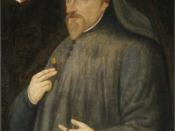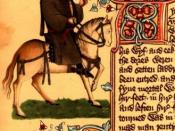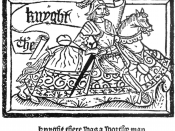Chaucer's attitude to the Church in the Prologue to the Canterbury tales.
Chaucer wrote the Canterbury Tales in the 14th Century. At the time the church had a very high status, and was very powerful. People went on long pilgrimages to visit holy places.
The Canterbury tales is about a group of pilgrims who each told stories on their pilgrimage to Canterbury. Many of the pilgrims were a part of the church. There was a prioress, a monk, a friar, a parson, a nun, three priests, a pardoner, and a summoner. In the prologue Chaucer shows his opinions of the church when he writes about these religious characters.
The first religious character, the Prioress, is an important nun, who also brought with her another nun and three priests. Nuns should have no possessions, live simple lives, should eat simple food, and look after the poor, sick and needy.
Chaucer describes a lady, known as Madame Eglentyne, who he describes as vain, and who eats very good food.
''Ful semely after hir mete she raughte.'' (Attractively she reached for meat to eat).
When he talks about her morals. He talks of her very strong feelings for her pet dog.
"But soore wepte she if oon of hem were deed,'' (But sore she'd weep if one of them were dead,)
Or if men smoot it with a yerde smerte" (Or if men hit it with a rod to hard)
Chaucer doesn't comment on how the prioress feels about the poor. You get the impression that they don't mean anything to her.
She has jewelry, expensive personal items which nuns should not own.
"Of smal coral aboute hire arm she bar
A peire of bedes, gauded al with grene
And theron heng a brooch of gold ful sheene,"
Another example of...


